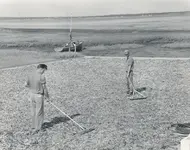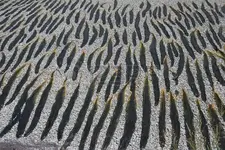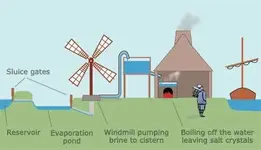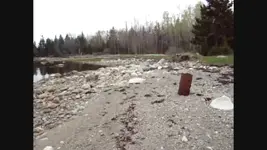Wrong on all counts....
My theory as to how to works has not changed at all...
"The resivor pond theory does not explain the beach." he is saying the same thing...but has used the word 'dyke' for the cofferdam separating the two
Where I veer off from his theory is that I don't think the sand was dried out (or semi)....
You cannot have it both ways. D.King argues that
Because of the relatively cold climate of maritime Canada, producing the salt by solar evaporation was not feasible.
Yet the method you are proposing is evaporation… Therefore you are saying his is wrong… rIght?
That a certain water level was kept in the pond area and as it dropped it was added to, left to evaporate some more, and then let into the well before the sand had dried out. The reason for this is then you are using water already concentrated and not 'new' sea water that would dilute the already concentrated water.
So your view is there is water over the whole beach or is not over the whole beach? How could higher water then has evaporated be let back over the sand without letting in new sea water?
If there was sand, (and not just wave action sand brought in from after the cofferdam was gone in the years since)...then the water already in the pond would concentrate the brine to an even higher salinity as it traveled through it.
Sorry how many feet of water is being concentrated in the dam? Up to the top of the beach?
How many gallons of water does the sump hold? How many gallons of water are you speculating are being held inside the dam?
As soon as the drain was open the sump would be full with virtually no effect on the water inside the dam.
But either method would work...I just believe mine to a higher degree of salinity, which is the whole point...
what evaporation? Are you claiming water that was 4-5 feet deep would evaporate enough in that climate to increase the salt concentration? How many inches per day are you speculating would evaporate from this significant sized and depth dam.. Do you havew anything to support high levels of evaporation.
(Side point: there is little in the way of evaporation from the swamp.)
(a) Seepage is going to happen no matter what configuration you used, but not under water with the same pressure on both sides of the cofferdam...the water would equalize and not go anywhere, with slightly more pressure on the seaward side if the evaporation pond side was at a lower level...maybe gain a bit from the slight pressure differential between the seaward side and the lower pond inside the cofferdam
So you believe there would be no natural transference of the ocean between the outside of the dam the inside?
(b) rain is just part of the game, you get the salt during the non rainy season and store it (under that roof) in the dry...just the same as in other parts of the world...and like the article said, they generally have 16 weeks to do so....OI may have had 8 or 4 or 12 or 20...but whatever it was, they took advantage of it
So if it rains heavy in the ‘non rainy season” the whole effort or process is made pointless…
Pretty easy to convince people the effort needed to build this system when a heavy rain can kill off most of your salty (sunny) period (How many days are you speculating it takes the evaporate of this water to a high enough effort to concentrate the salt. Especially seeing new water is being added any time the water drops.
(c) why would the beach need to be flat or smooth? Water evaporates off the top...it doesn't care what shape the bottom is, nor how deep it is...but using 5 foot of stones could explain the bottom being flatter, and staying that way.
It effects how much water is in the dam and how much water can be transferred to the sump. You seem to think there would be significant evaporation in your dam. I do not. In this climate (As also sated by D.King water evaporation is minimal and evaporation would not be an effective method to make salt in this climate/location).
All that matters is the water level is above the drains level...by how much they would determine as to the salinity of the water when they wanted to draw some off into the well...
How does the drains relate to the beach. Nothing you have said above addresses why the beach was built with the method described. Your method has water always over the drains. What is the need for the beach. The water at the drains entrance is what will go in the drains.
I am sorry I now disagree with you on two main things
1. The method you are describing is nothing like D.Kings article and his theory is in direct contradiction with what you are proposing. It is a complete new theory. Once again
Because of the relatively cold climate of maritime Canada, producing the salt by solar evaporation was not feasible
2. The method you are putting forward makes zero sense as a way of trying to concentrate salt on OI. The method you are proposing has never been offered by anyone as a possible way that salt was produced on OI.
Please offer something in the way to support this method of making salt on OI.
So far all you have offered is that salt was needed…















